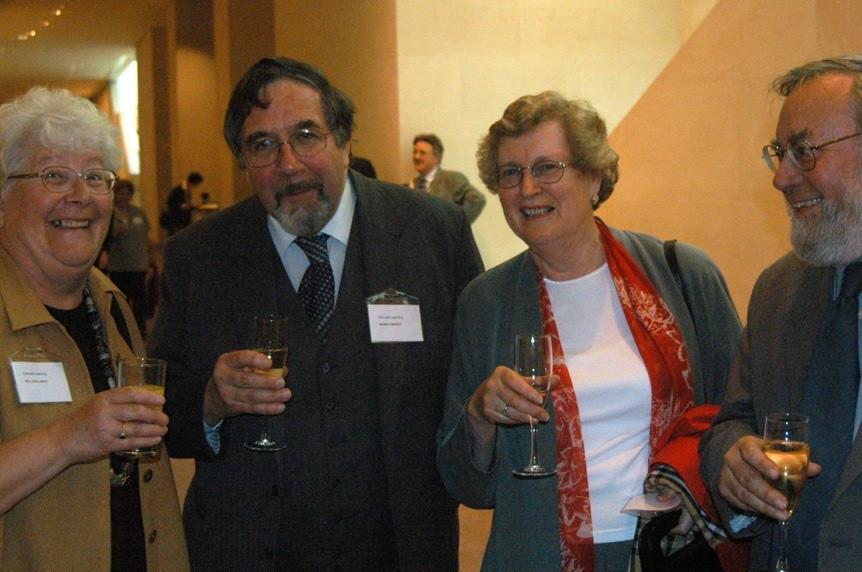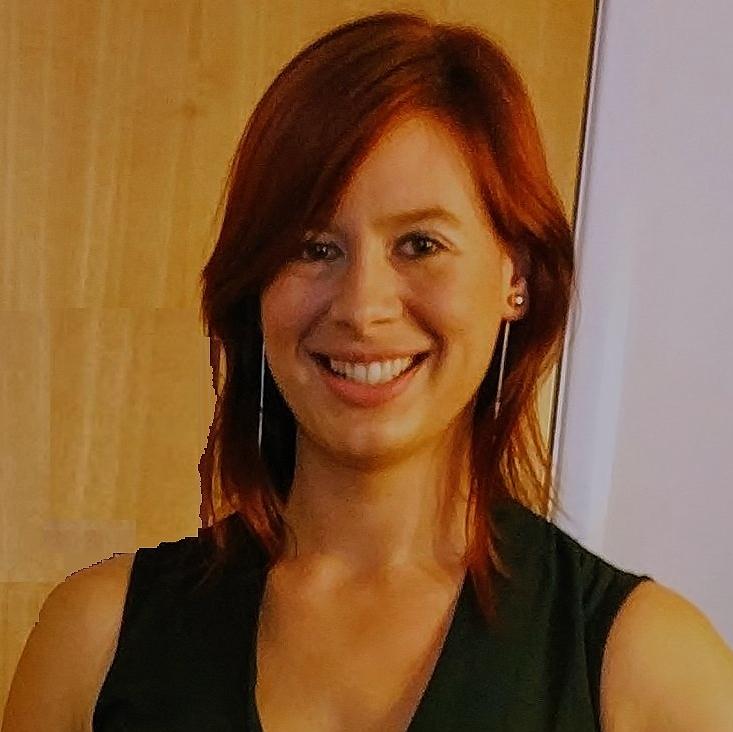We were deeply sorry to hear of the passing of ex-Director Pat Story, who remained an active part of the CSCP familia right up until her death at the age of 93. Here current Director Caroline Bristow reflects on Pat's extraordinary contrubutions to classrooms around the world.

Submitted by Caroline Bristow on Thu, 10/04/2025 - 10:52
Jill Dalladay, Robin Griffin, Pat, and Roger Dalladay at the launch of the CLC e-learning software at the British Museum in 2004.
Being the Director of CSCP is a deeply strange job. I never know whether it is funny, frustrating, or comforting when I read or hear accounts of previous Directors’ tenure and see in them almost exactly the same stresses and problems, the same debates, the same disagreements. But you can also see the same purpose and the same joys: the same focus on classrooms and teachers, the same dedication not just to Classics education, but to the students who experience it. CSCP has been a constant presence in the UK Classics community for almost 60 years, and Pat Story was a constant presence in CSCP.
Pat joined Hughes Hall in Cambridge in 1953 for her PGCE, and after nine years as a teacher, was appointed as an assistant lecturer in the Oxford Department of Education. In 1967—less than a year after CSCP was founded—she joined the team as Evaluation Officer. She combined her work as a lecturer and trainer of Classics graduates on the PGCE with her CSCP role, becoming Deputy Director in 1976 and Director in 1987.
Pat always let CSCP’s work, especially the CLC, shine and take centre stage. When she wrote or spoke about her history with the Project, her anecdotes were about teachers and classrooms, rather than behind-the-scenes experiences. In the article she wrote for James Morwood’s The Teaching of Classics (2003), she steps so lightly into the narrative that one could almost think she was incidental. It was Pat’s way to highlight the achievements and brilliance of others—Robin Griffin, Jill and Roger Dalladay, and Jean Hubbard to name but a few—rather than focus on her own contributions.
... if Pat had not been appointed to the Project in 1967, the CLC might never have survived to become more than just a great idea, let alone a publishing phenomenon.
Despite this modesty, one was always left with the suspicion that, as long-term collaborator Ben Harris comments, “…if Pat had not been appointed to the Project in 1967, the CLC might never have survived to become more than just a great idea, let alone a publishing phenomenon. I cannot help thinking that she marshalled the rest of them from the outset. My only frustration was that I was never able to get from her what it was really like at CSCP in the early days - apart from her saying that a lot of paper ended up in the bin! She was far too modest - and discreet!”
Her links to schools and the teaching community meant she was always one step ahead
Pat knew the CLC inside out. She weathered every bump in the road and helped the course adapt to every circumstance. Her links to schools and the teaching community meant she was always one step ahead, able to anticipate their needs and spot opportunities. One example Pat was particularly proud of was the Graded Test initiative, which is still running for the 4th edition today (and will be adapted for the 5th UK edition in due course). The role these tests played in recognising student achievement—regardless of whether they sat an external examination—was invaluable for teachers from the 1980s to today. We still send out hundreds of certificates a year and continue to moderate test marking to maintain the legitimacy and rigour Pat envisaged when she developed the initiative.
Even more significant was her championing of independent learning. The Independent Learner Manuals for the 4th edition CLC Books I–III are still sold by CSCP, and thousands of students of all ages have been guided through the course using them (a similar resource will eventually be created for the 5th edition). Characteristically, Pat was particularly gratified to learn that these resources were not only used by students but also by time-poor teachers in need of catch-up materials or cover work. Anything that improved a teacher’s ability to teach was always at the top of her priority list.
As Revision Editor, Pat knew precisely how to make the new edition a success.
Pat retired in 1996, and new Director Bob Lister took over a CSCP that ran like a well-oiled machine, supported by an engaged and passionate community of practitioners. Almost immediately after Pat stepped down, however, Cambridge University Press expressed interest in a colour edition of the CLC—something she had been advocating for for over five years. For Bob, there could be no one better to lead on this new challenge. As Revision Editor, Pat knew precisely how to make the new edition a success. The process came with its fair share of challenges and disputes, but her calm diplomacy and strategic thinking led to an edition that lasted over 25 years and included far more colour photographs than originally planned.
In the early-2010s, it was decided that North America needed a new edition, which then Director Will Griffiths wished to align far more closely with the UK 4th edition. So of course Pat would once again be central to the process. Ben Harris was at that time CUP’s commissioning editor for Classics, and he recalls that time fondly. The development meetings – held in Pat’s house – involved him, Will, Pat and Robin Griffin. The other three may have all had different aims and priorities but “Pat in her inimitable style managed us all to a sensible outcome that worked in the classroom.”
... that trademark wry smile, slightly shy laugh, and twinkle in her eye.
It was Ben who was the greatest advocate for the introduction of Caecilius’s daughter, Lucia:
“At first, Pat was dead set against Lucia. But when she came around to the idea, she embraced it - and even contributed the best original piece of content to the new edition, which was that wonderful story about Lucia and her brush with an undesirable marriage in Stage 11. Inimitably CLC - and she was already into her eighties! Of course, she would not have been Pat if she did not still introduce me to people as the one who was responsible for that girl - but never without that trademark wry smile, slightly shy laugh, and twinkle in her eye.”
When we began work on the UK 5th edition (which in turn formed the basis for the North American 6th), we kicked off with a meeting of the whole team, including of course, Pat. It was March 2020, just days before the world shut down. All subsequent conversations were held online, and we had to completely reimagine what the development process would look like. But Pat was still involved. She used our online platform to offer feedback on materials, draft stories, send emails detailing points for consideration, and review every manuscript before it went into production. Her feedback on Book 3 was especially valuable, and she remarked how difficult that book had always been to get right. She was hopeful that maybe this time, we would crack it.
Pat was the quintessential critical friend
Pat was the quintessential critical friend: her support took the form not only of praise but also of robust challenge. She would always tell us if she felt we were about to make a mistake or overlooking a potential pitfall—but her observations were delivered with the utmost professional respect and a sincere openness to being proved wrong. Her fierce intelligence and strong views were coupled with humility and a genuine interest in others’ perspectives—a rare and valuable combination.
Pat never stopped wanting to understand modern classrooms, students, and teachers. We invited her to all our events and talks, and she often attended—both online and in person. She would send us her thoughts about speakers or initiatives, and her greatest praise was reserved for those who truly “got it”: the teachers who understood the CLC and how it could be used to excite students about the ancient world. She loved seeing people engage with CSCP’s work and believed passionately that without our teachers and community, the Project would not be a fraction as successful.
To return to my opening statement: being the Director of CSCP is indeed a strange job. It’s a role I’ve had the privilege of holding since 2017/18, but carrying the weight of CSCP and its history is no easy task. Soon after I took it on, Pat invited me to her house for coffee. We sat and talked for hours. She calmly helped me understand how others might perceive me, corrected my misunderstandings, listened to my ideas, gave me new information, and provided copious amounts of biscuits. I left with the impression that while she wanted to ensure I would take good care of CSCP and the CLC, she was also interested to see what I might bring to the table.
She had seen it all before.
I always looked forward to visiting Pat for coffee and a CSCP update when I got the chance—as did other members of the team who also enjoyed popping over. During one of the periodic crises that has beset CSCP over the years, Ben remembers one such chat: “She had seen it all before. I thought the world had ended, but she said, ‘CSCP has come through far worse crises than this.’ Her focus was never distracted from what was best for the Project and the CLC, and she saw beyond the boardroom politics and all the rest of it.”
I cannot express how important her acceptance and guidance were to all of us, and I am saddened beyond measure that future Directors and CSCP colleagues will not have the benefit of her wisdom.
So it is with heavy hearts that we say “vale, Pat Story”—and thank you.
Bob Lister



